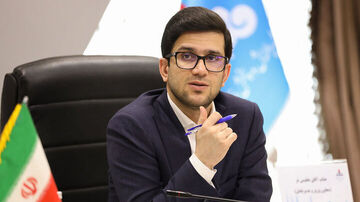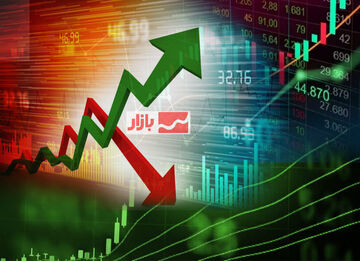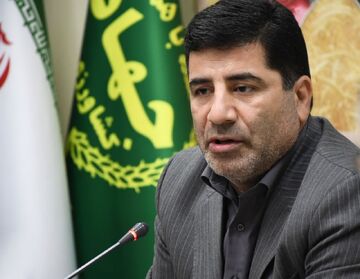Tehran(Bazaar): With this strategic deal, China and Iran have sent a strong signal to Washington DC that they will be on the same camp vis-à-vis the US’s declared Cold War, Mehmet Ogutcu said Bazaar in an exclusive interview.
Noting that the trade between the two countries has consistently been decreasing since as a result of U.S. sanctions against Iran, and there has been no move toward deeper trade relations, he also said that despite the fanfare surrounding the 25-year deal, details are still scarce and this is not a new development.
Bazaar: 25-year co-operation document between Iran and China was signed. What is the significance of this document for the two countries?
Mehmet Ogutcu: Despite the fanfare surrounding the 25-year deal, details are still scarce. This is not a new development. China and Iran first announced that they were establishing a comprehensive strategic partnership during President Xi Jinping’s January 2016 visit, with an ambitious goal of increasing bilateral trade from a modest $32 billion that year to $600 billion by 2026. The reality is that trade between the two countries has consistently been decreasing since as a result of U.S. sanctions against Iran, and there has been no move toward deeper trade relations.
The agreement, dubbed the Comprehensive Strategic Partnership since 2016, covers a variety of economic activity from oil and mining to promoting industrial activity in Iran, as well as transportation and agricultural collaborations. The deal also supports tourism and cultural exchanges. It comes on the 50th anniversary of the establishment of diplomatic relations between China and Iran.
The deal, characterized as “deep, multi-layered, and full-fledged”, marked the first time Iran has signed such a lengthy agreement with a major world power. In 2001, Iran and Russia singed a 10-year cooperation agreement, mainly in the nuclear field, that was lengthened to 20 years through two five-year extensions.
China made pointed comments about “unreasonable unilateral sanctions imposed on Iran” and “the evil consequences of external interference on the regional situation,” clear references to the United States’ policy toward Iran.
China is prepared to invest $400 billion in Iran over the deal’s 25-year term, in exchange for unprecedented access to Iranian ports and islands.
That, in turn, sparked fears of lost sovereignty among Iranians, where Chinese investment is a sensitive issue. It neither includes any quantitative, specific contracts and goals nor targets any third party, and will provide a general framework for China-Iran cooperation going forward. Instead, it’s “an aspirational document” that “provides no methods for enforcement, measurable goals, or specific programs.”
Despite the fanfare surrounding the agreement, something is still holding China-Iran relations back – whether that’s Chinese reluctance to tangle with Iran’s sanctions-ridden economy, Iranian fears of lost sovereignty, the complex geopolitics of the Middle East, or a combination of all three.
Iran and China have done some $20 billion in trade annually in recent years. That’s down from nearly $52 billion in 2014, however, because of a decline in oil prices and U.S. sanctions imposed in 2018 after then-President Donald Trump pulled the U.S. unilaterally out of a nuclear deal between Iran and world powers, saying it needed to be renegotiated.
China has many strengths but also many vulnerabilities. The US has great weaknesses but also a remarkable dynamism and capacity to re-invent itself. But as the Covid-19 pandemic has demonstrated in stark terms, what happens in China does not stay in China. It is a world player that matters to all our lives.
Bazaar: In terms of time, what messages does the signing of this document have for the United States?
Mehmet Ogutcu: The global context is different today. In the Cold War, the world was divided into two static camps, plus a significant non-aligned bloc (which was often seen by the West as favouring the Soviets). Today we have an essentially multi-polar world, but one in which the institutions of the liberal world order are under threat like never before. This gives China leverage in seeking to impose its own world view.
Relations between the US and China are the worst they have been for many years and look set to become worse still. The Biden team bluntly stated that "the era of engagement with China has come to an unceremonious close". It has become commonplace to describe the US-China relationship as a new "Cold War", a reference to the generation-long rivalry between the US and the Soviet Union that cast a shadow over the latter half of the 20th Century.
China’s rapid economic growth has challenged America’s dominant influence not only throughout East Asia, but also in major regions of the world including the Middle East and the Gulf. As the U.S. and China struggle to avoid a “new Cold War,” many nations are forced to straddle growing fault lines between the two great powers.
Iran evidently made its choice at an earlier stage in favour of partnership with China (and Russia). With this strategic deal, China and Iran have sent a strong signal to Washington DC that they will be on the same camp vis-à-vis the US’s declared Cold War.
Bazaar: During Iran foreign minister, Zarif's visit to China, the Chinese Foreign Minister somehow tied the signing of this agreement to the settlement of Iran's disputes with the countries of the region. But he has now travelled to Iran to sign the agreement. Has there been a change in China's view since Biden came to power in the United States? In other words, has China been waiting for the policy of the new US administration?
Mehmet Ogutcu: While Beijing and Tehran find political benefits in touting their relationship, the actual results lag behind Chinese engagement with Iran’s Gulf rivals. In short, this agreement represents an attempt to bring Sino-Iranian relations back in line with the rest of the Middle East, rather than expansion of beyond the norm for China’s engagement with the region.
Let’s not forget: China has more significant economic and security relationship with the Gulf nations which are viewed as a hostile block to Iran’s interest. China’s investment in Iran from 2010 to 2020 amounted to $18.2 billion. During the same period, China invested $30.6 billion in Saudi Arabia and $29.5 billion in the UAE.
Therefore, it is important for Beijing to be tactful and balanced towards Iran and the Gulf in its strategic outreach. As Beijing is on speaking terms with both and has a strategic interest to keep in the forefront in securing access to the region, it is only natural that it will attempt to reconcile the differences and ease the tensions involving Iran.
Furthermore, we should also bear in mind that China’s economic relationship with the United States is much more important than a partnership with Iran, and Beijing has demonstrated time and again that it will not risk damaging its ties with Washington for the sake of business with Iran.
Also, a new dynamic is that President Biden will resuscitate the foreign policy of Barack Obama and return to the Iran nuclear deal after Trump has pulled out of it.
All these are to say that Iran’s ties with China will not be exclusive and will likely be tempered with other strategic interests both sides are engaged in.
Bazaar: One of the important issues raised for this cooperation document is Iran's land connection to Iraq and Syria. In this way, China can connect to the Mediterranean Sea through Iran, Iraq and Syria. Iran has a strong presence in the Syrian port of Tartus, and pro-Iranian forces also control the Bokmal border crossing in Syria's Deir ez-Zor province and the al-Qaim crossing in Iraq's Anbar province. How feasible do you think this path is?
Mehmet Ogutcu: Yes, indeed it will be possible for China to reach the Mediterranean via Iran’s land connection to Iraq and Syria – three countries viewed in Beijing as friendly and allied to China more than they are to the US. Turkey provides another connection to the Mediterranean and Europe via the Caspian region.
More than seven years after Chinese President Xi Jinping announced his country’s Belt and Road Initiative (BRI), the vast infrastructure and economic development project has emerged as the most significant and ambitious strategic initiative of the twenty-first century so far. The initiative is intended to link Asia to Europe via Africa and the Middle East, spurring investment and increasing global economic integration on terms largely set in Beijing.
Anticipated Chinese investments could amount to well over $1 trillion by 2027, primarily in transportation nodes such as ports and airports, as well as road, railway, and telecommunications networks, and power generation plants. Fifty special economic zones along the routes are planned as well.
There is no doubt that the project has had its troubles, including sustainability questions, accusations of corruption, and the perception of BRI as a front for Chinese hegemony
In the Middle East, the BRI could force the US to redefine its role in the region even as Washington contemplates reducing its military and diplomatic footprint. Such a strategy could play an important role in the United States’ overall response to China’s assertive political and economic game, a response that is sure to be rethought by the Biden Administration.
Since BRI was inaugurated, Beijing has pumped at least $123 billion into the Middle East in BRI-related project financing. Several countries there are slated for major port and infrastructure projects, including Saudi Arabia, the United Arab Emirates, Oman, Djibouti, and Egypt. Iran and China are also working closely together - the enormous 25-year, $400 billion trade and security pact attests to that expanding partnership in the context of the BRI.
China’s Middle East trade focus is Gulf-centred. The future of these trade ties will be channelled through Beijing’s “1+2+3” wider BRI model: hydrocarbon-based energy as the primary focus; expanding trade and investment alongside infrastructure projects as two extensions from this primary focus; and cooperation on “new” energy, nuclear energy and space as three peripheral areas of potential promise.
Iran – with the proliferating presence of Chinese factories as well as road, rail, and port projects, amongst other developments – has been well-covered as the central node of BRI expansion in the Middle East.















نظر شما